Experimental Biophysics & Optical Manipulation
We investigate the physical properties of both living cells and soft matter using an array of optical and micromanipulation approaches including optical tweezers, thermoplasmonics and micromanipulation.
We employ methods from physical chemistry, nanoscience and advanced imaging to investigate biological specimens ranging in size from molecular scales to macroscopic embryos and cancer spheroids.
We are a group of enthusiastic and creative scientists interested in understanding physical properties of biological systems at the single molecule to whole cell level.
The group has a strong interdisciplinary profile with a number of close collaborators in biology, nanoscience, medicine, chemistry and theory (see staff section for more details).
We have dual optical trapping platform combined with a confocal microscope which allows cutting edge experiments to be performed. Also, we have super resolution microscopy based on the STORM method. For imaging larger specimens, like embryos, we have light sheet microscopy which facilitates fast and low photo-toxicity imaging. Microscopic physical properties of cells are quantified using an optical trap as a force sensor/actuator whereas whole cell properties can be explored using the cell deformation cytometry.
Additionally, we have an extensive expertise in working with model membrane systems and also isolated plasma membrane systems containing the membrane proteins from the cell.
We are located at the Niels Bohr Institute at the University of Copenhagen
Living cells have interesting mechanical properties and behave like active materials. Investigation of these is done by advanced optical microscopy combined with optical manipulation. Due to the immense complexity of living cells we also study the biophysics of reconstituted model systems which are simple systems containing only a few cellular components. Major areas of research include the biophysical properties of the cell surface and viscoelastic properties of the cellular cytoplasm. Development of advanced optical techniques, like optical trapping and nanoscale thermoplasmonics, allows us to perform state-of-the art experiments to answer scientific questions in biophysics.
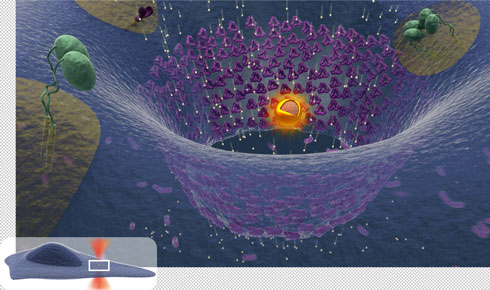
Tumor elimination We investigate biophysical properties of a number of biological systems ranging from single stem cells to invasive cancer cells. The cells are investigated as single cells, but also in their natural complex environment where they can grow and interact freely in three dimensions. The core aspect of our research deals with how the physics of the cell affects or controls diverse biological functions. The main research areas include mechanical investigations of the cell surface, these include the cell membrane, and associated membrane proteins, as well as viscoelastic properties of the cell interior.
The biological complexity inherent in most living systems makes it difficult to examine the function of single components in a biological system. Therefore, we invest significant efforts into the development of minimal model systems which allow us to investigate single proteins in cell-like systems that contain only few biological components. Moreover, we also develop and test cellular model systems like 'organoids' to understand how tumors grow and develop.
The building of advanced equipment has been an integral part of the research group and has provided the platform for a number of state-of-the-art experiments which have been conducted to address fundamental scientific questions in both nanoscience and biophysics.
Projects:
Vi har mange forskellige projekter for Kandidat studerende og også lejlighedsvis projekter for bachelor studerende. For yderligere info kontakt Poul M. Bendix (Bendix@nbi.ku.dk) eller Liselotte Jauffred (jauffred@nbi.ku.dk).
Cellular repair system investigated by laser based nano-surgery
When cells migrate in the body they often experience membrane ruptures which results in excessive calcium flowing into the cell. This can be lethal unless the membrane is sealed within milliseconds. Cells have a built-in surface repair kit which is activated by calcium influx and hence can allow the cell to self-heal within seconds after injury. Cancer cells are extremely efficient in repairing their surface since they have an increased expression of various annexin proteins which are thought to be the major proteins involved in the membrane repair.

The project will involve testing the membrane repair system in cells by using thermoplasmonics to inflict a nanoscopic hole in the membrane. This will be done by irradiating a plasmonic gold nanostructure placed on the surface of the cell. Confocal microscopy and super-resolution microscopy will be used to monitor the recruitment of various annexins which are labeled with fluorescent proteins. The overall aims are to i) investigate whether invasive cancer cells are more efficient in dealing with thermoplasmonic ruptures than non-invasive cells ii) investigate the role of several different annexins in the repair process including other proteins like ESCRT and actin.
The project is a collaboration with Kræftens Bekæmpelse samt Syddansk Universitet.
Contact: Poul Martin Bendix, bendix@nbi.dk
Patterning in large bacterial communities
 In nature, bacteria actively search for a surface to form larger communities, i.e., biofilm, with extended cooperativity and defense. We know that sectors with low genetic diversity form within the colony, even among cells of similar fitness. This self-organization of microbial cell communities is the result of genetic drift in complex interplay with evolution, competition, and cooperation.
In nature, bacteria actively search for a surface to form larger communities, i.e., biofilm, with extended cooperativity and defense. We know that sectors with low genetic diversity form within the colony, even among cells of similar fitness. This self-organization of microbial cell communities is the result of genetic drift in complex interplay with evolution, competition, and cooperation.
We offer various projects to explore pattern formation by growing bacteria both in vivo and in silico. We believe the close interplay between theory and experiments will provide a more complete understanding of cooperation and competition among cells in larger communities. We aim to point out general features of growth pattern, which can be generalized in wider class of systems. In the long term, we may draw parallels to mammalian cell systems, where patterning is crucial for example in embryonic development.
Possible subprojects include:
Colony shape
The relation between the individual cell shape and the colony shape
This project combines theory and experiments depending on your interests. Experimentally, the project can include bacterial cell culture, colony growth, and advanced fluorescence microscopy. Theoretically, we plan to first simulate an individual cell-based model where the particles grow, divide, and interact through mechanical force. Depending on the development of the project, simplified lattice models or partial differential equation-based models can also be used.
Supervisors: Liselotte Jauffred & Namiko Mitarai
Joshua Brickmann, Danstem, University of Copenhagen
Jesper Nylandsted, Kræftensbekæmpelse
Elke Ober, Danstem, University of Copenhagen
Janine Erler, Biotech & Research Innovation Center (BRIC) University of Copenhagen
Robert Daniels, Dood and Drug Administration, the States
Karen Martinez, University of Copenhagen
Adam Cohen Simonsen, University of Southern Denmark
Himanshu Khandelia, University of Southern Denmark
Weria Pezeshkian, University of Groningen
Christine Selhuber-Unkel, Institute for Materials Science, Kiel University
Petra Hamerlik, Brain Tumor Biology, Danish Cancer Society Research Center
Kirstine Berg Sørensen, Biophysics, Danish Technical University
Ralf Metzler, Technical University of Munich
Karina K. Sand, Molecular Geobiology Group, University of Copenhagen
Henrik Siegumfeldt, Microbology and Fermentation, Department of Food Science, University of Copenhagen
Active grants:
-
StemPhys: Danish National Research Foundation Center for Stem Cell Decision Making 60.000.000 Dkr granted by Danish National Research Foundation, 2015-2021. PI: Joshua Brickmann, Danstem. Click HERE to see the homepage of StemPhys.
-
A multidisciplinary platform for revealing mechanisms of annexin-mediated plasma membrane repair 3.748.705 Dkr granted by The Novo Nordisk Foundation. 2019-2022. Co-applicant: Poul M. Bendix, NBI (PI Jesper Nylandsted, Kræftens Bekæmpelse).
-
Coupling Celluar Shapes Sapere Aude Grant from Danish Research Councils 7.000.000DKK, 2015-2019. PI: Poul M. Bendix, NBI.
- Lundbeck PhD fellowship (2017-2020), PI Poul M. Bendix
Coming to the Experimental Biophysics with an external grant
The Experimental Biophysics supports researchers' applications to international and Danish public and private funding agencies.
If you come to the group with your own funding, you will become a full member of the team with office space, access to IT and admin support, laboratories, and you are expected to contribute to the scientific and social life in the group.
Examples of agencies funding research in biophysics in Denmark:
-
Independent Research Fund Denmark | Natural Sciences (FNU) and Medical Sciences (FSS) - public; postdocs, phd's, research groups, mobility
-
European Research Council (ERC) - international; research groups
-
European Commission Horizon 2020 - international; postdocs, mobility
-
Novo Nordisk Foundation - private; postdocs, research groups, mobility
- Lundbeck Foundation - private; postdocs, phd's, research groups, mobility
.. and several others. You may also consider applying for funding from private or national agencies in your home country, and name the Optical Tweezers Group at the Niels Bohr Institute as your host institution.
Procedure
Contact Group Leader, Assoc. Prof. Poul Martin Bendix, if you are considering applying for external funding.
Please contact us:
- at least 8 weeks in advance of the application deadline in the case of individual post doc stipends and smaller projects (i.e., 1-3 years, under DKK 3M);
- at least 3 months in advance of the application deadline in the case of larger projects.
The group's faculty will review your request to apply. The Niels Bohr Institute may be able to offer some co-funding in the case of larger projects/grants. A needs assessment for equipment may also be conducted, to ensure that the Institute can adequately house your project and the expected personnel associated with it.
If approved, we can provide considerable support for the application process, for example including budget development, text about the host institution, review of application's science case, and contact with the funding agency if needed. The Faculty of Science Research Funding Office at the University of Copenhagen also provides support for applications.
An application budget is developed online using the University's application tool and must be approved by the group leader and the Niels Bohr Institute at least one month before the application deadline. The budget process also facilitates the conversation about possible co-financing from the Institute or Center, laboratory set-up if needed, and any HR issues that need to be addressed.
Information for group members
Group meetings on Mondays at 1PM.
Group meetings are paused July and August as well as throughout January. Participation in the group meetings is mandatory and all scientists interested are also welcome. All questions regarding the group meetings should be addressed to Liselotte Jauffred.
For lab reservations see bottom of the page.
For an update on who presents please check the event calendar on the homepage.
Presentations spring 2021
| Date | Responsible | Content |
| 10.02.21 | Alba | project presentation |
| 24.02.21 | Martin | project presentation |
| 10.03.21 | Guillermo | project presentation |
| 17.03.21 | Mads | project presentation |
| 14.04.21 | Mohammad | project presentation |
| 28.04.21 | Mireia | project presentation |
| 05.05.21 | Natascha | project presentation |
| 12.05.21 | Helena | project presenation |
| 19.05.21 | Younes | CTRAP presentation |
| 02.06.21 | Victoria | project presentation |
Presentations Fall 2020
| Date | Responsible | Content |
| 09.09.20 | Mohammad | project presentation |
| 16.09.20 | Christoffer | project presentation |
| 23.09.20 | Martin | project presentation |
| 30.09.20 | Guillermo | project presentation |
| 07.10.20 | Mads | project presentation |
| 14.10.20 | Autumn vacation | |
| 21.10.20 | Helena | project presentation |
| 28.10.20 | Mireia | project presentation |
| 04.11.20 | Mathias | Project presentation |
| 11.11.20 | Melanie | project presenation |
| 18.11.20 | Paul | project presenation |
| 25.11.20 | Natascha | project presentation |
| 02.12.20 | Safia | Project presentation |
| 09.12.20 | Signe Mathiasen | Project presentation |
Spring 2020
| Date | Responsible | Content |
| 05.02.20 | Mohammad | project presentation |
| 19.02.20 | Natascha | project presentation |
| 26.02.20 | Younes | project presentation |
| 11.03.20 | Christoffer | project presentation |
| 18.03.20 | KU-closed | KU-closed |
| 25.03.20 | KU-closed | KU-closed |
| 01.04.20 | KU-closed | KU-closed |
| 08.04.20 | Easter Holiday | |
|
All presentations will be online until KU opens |
online platform ZOOM |
Click here to join |
| 15.04.20 | Pavlina | project presentation |
| 22.04.20 | Joshua | project presentation |
| 29.04.20 | ||
| 06.05.20 | Helena | project presentation |
| 13.05.20 | Andreas | project presentation |
| 20.05.20 | Mads | project presentation |
| 27.05.20 | Liselotte | paper |
| 03.06.20 | Poul Martin | paper |
Booking of laboratories
We have 3 setups with optical tweezers where two of them are combined with a confocal microscope (Leica SP5). Google Kalender is used for bookings. Password: Ask Poul Martin.
| Setup | Noter | Login navn |
|---|---|---|
| OT1 | Dual trap | nbitweezer1 |
| OT2 | Single trap in Leica SP5 | nbitweezer2 |
| OT3 | Single trap, low power | nbitweezer3 |
| OT4 | Leica SP5 (2014), dual trap | nbitweezer4 |
| AcCellerator | Real-Time Deformability Cytometry | nbiaccell@gmail.com |
| Olympus | Light-sheet | |
| Olympus | No trap, confocal | otgroupolympus |
| Cell Lab | Flow Hood, incubators | Booking schedule on lab door |
During weekdays reservation slots run from before or after 2 PM. A maximum of 2 active timeslots per week and 4 per 2 weeks is allowed within normal working hours. Please only book two weeks in advance. The setups can be freely used during evenings and weekends.
Internal documents and wiki
The group has a wikipage for experimental protocols and manuals for the different lab equipment.
Contact Poul Martin for username and password.
 Poul Martin Bendix,Group leader
Poul Martin Bendix,Group leader
E-Mail: bendix@nbi.ku.dk
Tel: +45 35325251 or +45 61602454
Blegdamsvej 17, DK- 2100 Copenhagen
Staff
| Name | Title | Job responsibilities | |
|---|---|---|---|
| Search in Name | Search in Title | Search in Job responsibilities | |
| Bendix, Pól Martin | Associate Professor | Associate Professor, Group Leader |
|
| Farhangi Barooji, Younes | Academic Staff |
|
Master/undergraduate students
| Navn | Titel | |
|---|---|---|
| Malte Slot Lauridsen | MSc student | |
|
Hazal Polat |
MSc student | |
| Christopher Calvin Spenser Anthony | MSc student |
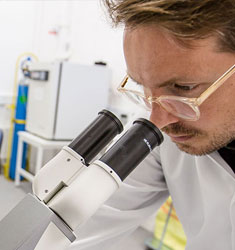
Experimental Biophysics Lab
We have a number of research facilities which we would also like to use for Research collaboration internationally, Industrial collaboration and Student projects.

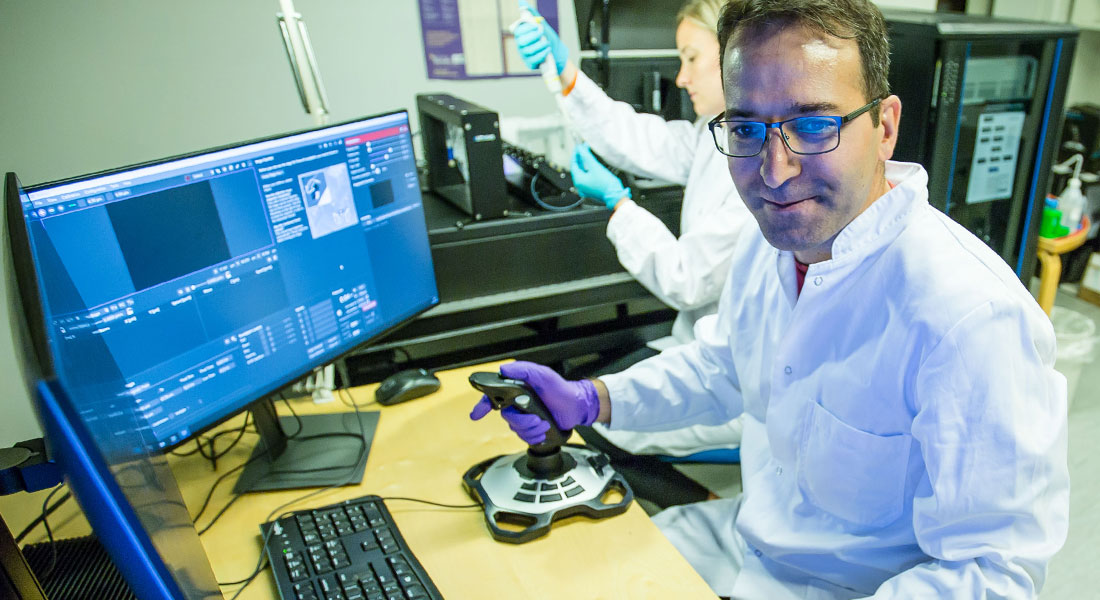
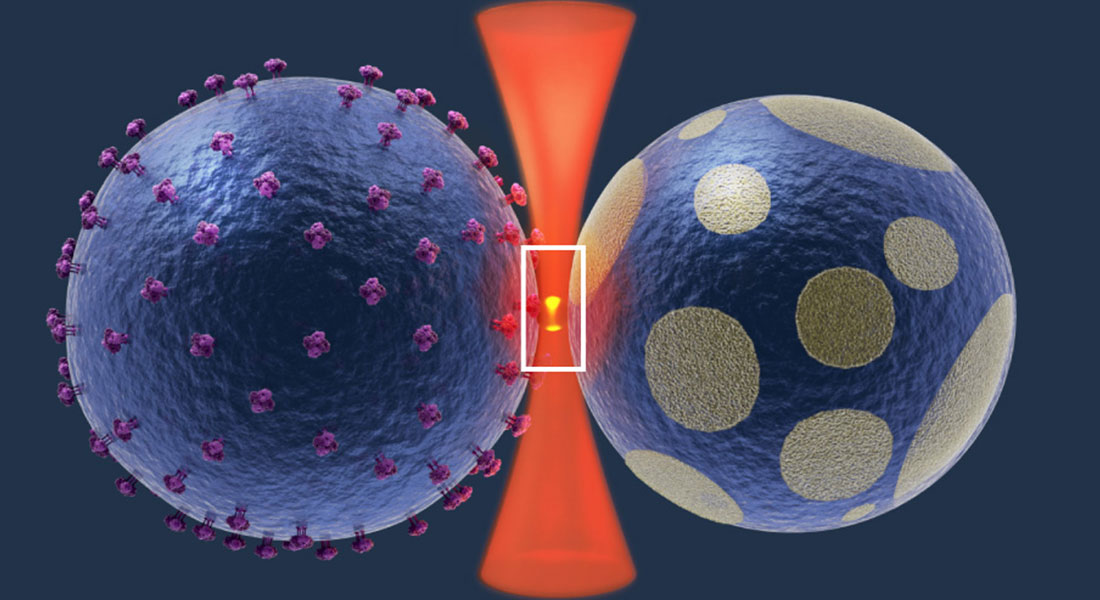
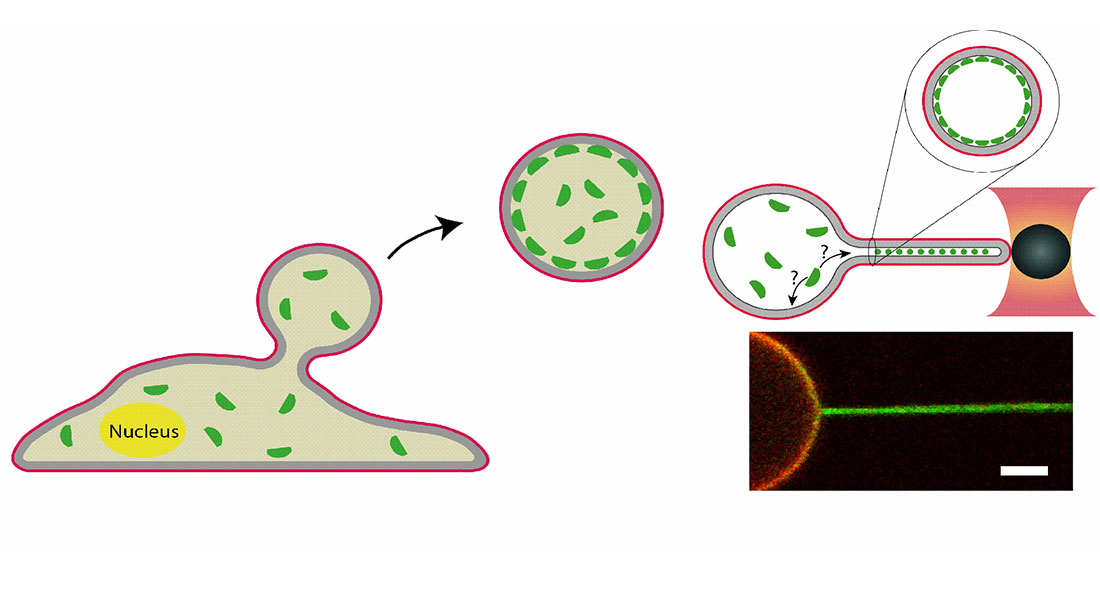
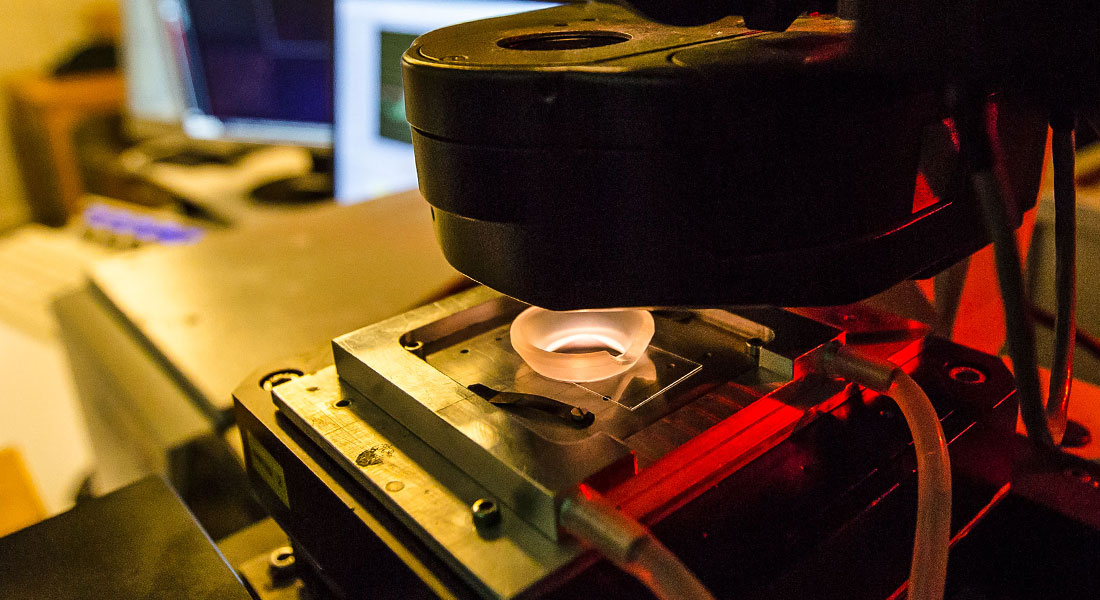
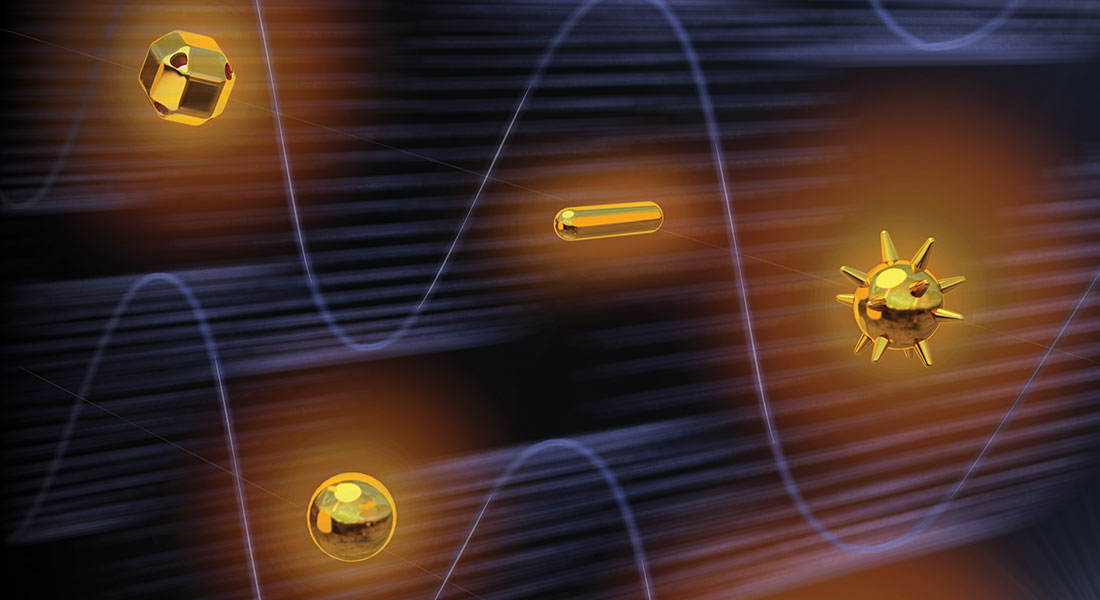
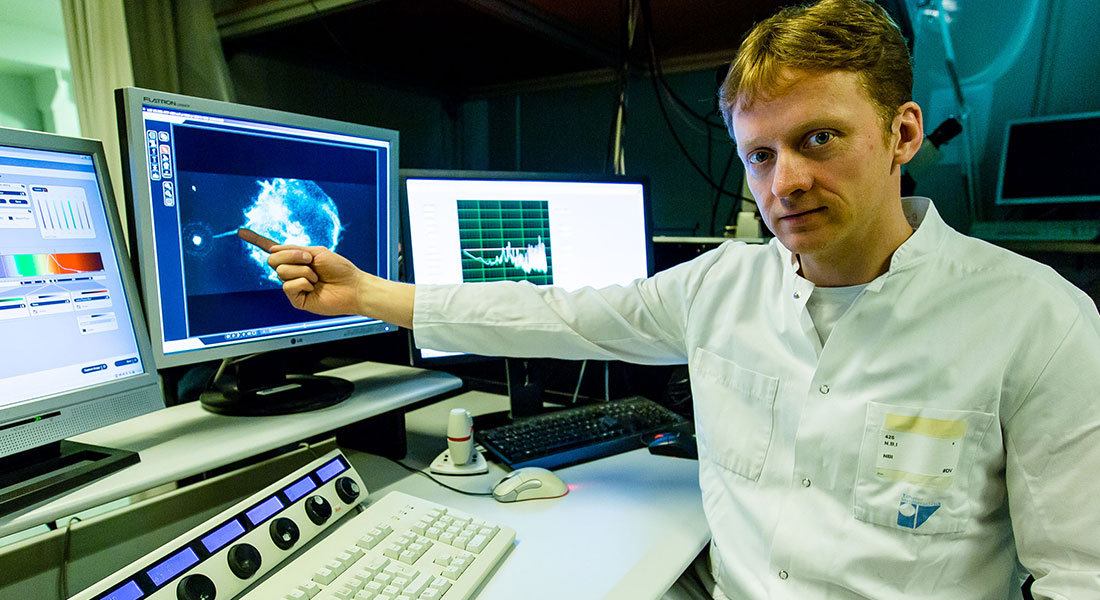
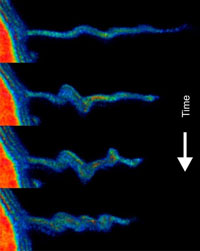 In this group of Projects our aim is to understand how cells dynamically organize their cell surface and perform all the functions associated with the surface of the cell. Examples include remodeling of the plasma membrane, cell - cell interactions, lateral redistribution of proteins in the membrane and membrane repair. We study these physical phenomena like filopodia dynamics, cell surface repair by annexins, membrane curvature sensing by proteins, lipid order in plasma membranes and resulting protein segregation into distinct lipid phases. To explore these phenomena we use confocal imaging, super resolution (STORM), optical trapping, plasmonic heating and membrane manipulation tools.
In this group of Projects our aim is to understand how cells dynamically organize their cell surface and perform all the functions associated with the surface of the cell. Examples include remodeling of the plasma membrane, cell - cell interactions, lateral redistribution of proteins in the membrane and membrane repair. We study these physical phenomena like filopodia dynamics, cell surface repair by annexins, membrane curvature sensing by proteins, lipid order in plasma membranes and resulting protein segregation into distinct lipid phases. To explore these phenomena we use confocal imaging, super resolution (STORM), optical trapping, plasmonic heating and membrane manipulation tools.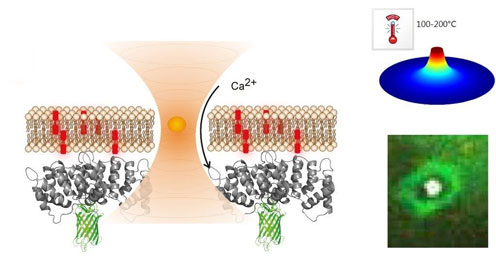
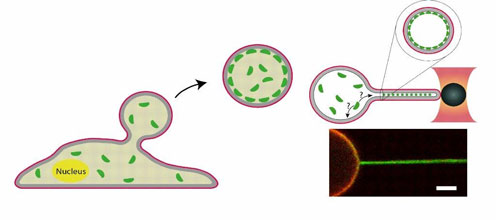
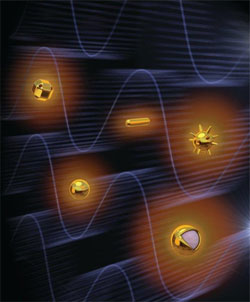 Our group has a long history of quantitative characterization of the optical trapping of nanostructures and micro particles. Trapping potentials and heating effects have been extensively characterized and published in numerous high impact journals (Chemical Reviews, ACS Nano, Nano Letters, Nanoscale, Scientific Reports).
Our group has a long history of quantitative characterization of the optical trapping of nanostructures and micro particles. Trapping potentials and heating effects have been extensively characterized and published in numerous high impact journals (Chemical Reviews, ACS Nano, Nano Letters, Nanoscale, Scientific Reports).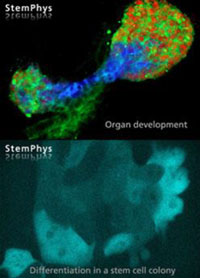 There does not yet exist a complete understanding of how biological, chemical and physical factors act in concerto to determine the destiny of a stem cell. The novel StemPhys center joins forces of stem cell biologists from DanStem and theoretical and experimental physics from the Niels Bohr Institute with the goal of significantly progressing our quantitative understanding of stem cell commitment.
There does not yet exist a complete understanding of how biological, chemical and physical factors act in concerto to determine the destiny of a stem cell. The novel StemPhys center joins forces of stem cell biologists from DanStem and theoretical and experimental physics from the Niels Bohr Institute with the goal of significantly progressing our quantitative understanding of stem cell commitment. Such plasmonic nanoparticles are extremely efficient light-to-heat converters and if a metallic nanoparticle is resonant, or close to resonant with the incoming light, the temperature elevation can easily reach hundreds of degrees Celsius.
Such plasmonic nanoparticles are extremely efficient light-to-heat converters and if a metallic nanoparticle is resonant, or close to resonant with the incoming light, the temperature elevation can easily reach hundreds of degrees Celsius.